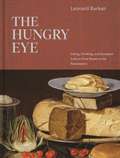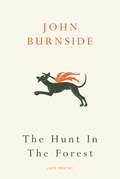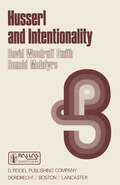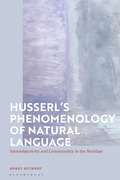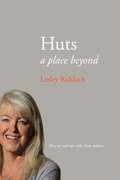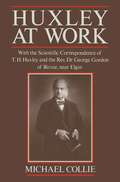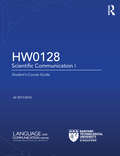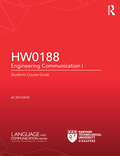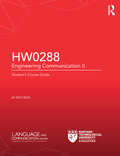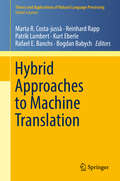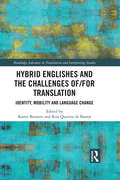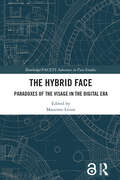- Table View
- List View
Hunger, Poetry and the Oxford Movement: The Tractarian Social Vision
by Lesa SchollFocusing on the influence of the Oxford Movement on key British poets of the nineteenth-century, this book charts their ruminations on the nature of hunger, poverty and economic injustice. Exploring the works of Christina Rossetti, Coventry Patmore, Gerard Manley Hopkins, Adelaide Anne Procter, Alice Meynell and Alfred, Lord Tennyson, Lesa Scholl examines the extent to which these poets – not all of whom were Anglo-Catholics themselves – engaged with the Tractarian social vision when grappling with issues of poverty and economic injustice in and beyond their poetic works. By engaging with economic and cultural history, as well as the sensorial materiality of poetry, Hunger, Poetry and the Oxford Movement challenges the assumption that High-Church politics were essentially conservative and removed from the social crises of the Victorian period.
The Hungry Eye: Eating, Drinking, and European Culture from Rome to the Renaissance
by Leonard BarkanAn enticing history of food and drink in Western art and cultureEating and drinking can be aesthetic experiences as well as sensory ones. The Hungry Eye takes readers from antiquity to the Renaissance to explore the central role of food and drink in literature, art, philosophy, religion, and statecraft.In this beautifully illustrated book, Leonard Barkan provides an illuminating meditation on how culture finds expression in what we eat and drink. Plato's Symposium is a timeless philosophical text, one that also describes a drinking party. Salome performed her dance at a banquet where the head of John the Baptist was presented on a platter. Barkan looks at ancient mosaics, Dutch still life, and Venetian Last Suppers. He describes how ancient Rome was a paradise of culinary obsessives, and explains what it meant for the Israelites to dine on manna. He discusses the surprising relationship between Renaissance perspective and dinner parties, and sheds new light on the moment when the risen Christ appears to his disciples hungry for a piece of broiled fish. Readers will browse the pages of the Deipnosophistae—an ancient Greek work in sixteen volumes about a single meal, complete with menus—and gain epicurean insights into such figures as Rabelais and Shakespeare, Leonardo and Vermeer.A book for anyone who relishes the pleasures of the table, The Hungry Eye is an erudite and uniquely personal look at all the glorious ways that food and drink have transfigured Western arts and high culture.
The Hungry Eye: Eating, Drinking, and European Culture from Rome to the Renaissance
by Leonard BarkanAn enticing history of food and drink in Western art and cultureEating and drinking can be aesthetic experiences as well as sensory ones. The Hungry Eye takes readers from antiquity to the Renaissance to explore the central role of food and drink in literature, art, philosophy, religion, and statecraft.In this beautifully illustrated book, Leonard Barkan provides an illuminating meditation on how culture finds expression in what we eat and drink. Plato's Symposium is a timeless philosophical text, one that also describes a drinking party. Salome performed her dance at a banquet where the head of John the Baptist was presented on a platter. Barkan looks at ancient mosaics, Dutch still life, and Venetian Last Suppers. He describes how ancient Rome was a paradise of culinary obsessives, and explains what it meant for the Israelites to dine on manna. He discusses the surprising relationship between Renaissance perspective and dinner parties, and sheds new light on the moment when the risen Christ appears to his disciples hungry for a piece of broiled fish. Readers will browse the pages of the Deipnosophistae—an ancient Greek work in sixteen volumes about a single meal, complete with menus—and gain epicurean insights into such figures as Rabelais and Shakespeare, Leonardo and Vermeer.A book for anyone who relishes the pleasures of the table, The Hungry Eye is an erudite and uniquely personal look at all the glorious ways that food and drink have transfigured Western arts and high culture.
The Hunt in the Forest
by John BurnsideTaking its title from Uccello's famous painting of a band of men - on foot and on horseback - massing for the chase, John Burnside's new poems take us on a journey out of the light and into the darkness, where we may just as easily lose ourselves as find what we are looking for. In these poems of hunting and predation, Burnside explores our most deep-rooted and primeval pursuits: romantic love, memory, selfhood, grief, the recollection of the dead. Yet just as we seek, so are we sought out: at any moment we may slide into loss or be gathered in by some otherworldly light; at any moment, the angel of the annunciation may seek us out and demand some astonishing transformation. Even in the pursuit of love, or in the exercise of memory, we fall into snares and become entangled in veils; just as we are always on the point of discovery, so we are always a hair's-breadth away from being lost. Concerned with love and mourning, with what we discover and what remains hidden - with learning how to follow the trail through the forest and find the way home - above all, these poems are about the quest: knowing that whatever we bring back from the hunt, it is always hard-won and never fully our own.With this extraordinary collection of fleet and deftly beautiful poems, John Burnside confirms his place at the forefront of writing, as one of a handful of truly important British poets working today.
Hunting Nature: Ivan Turgenev and the Organic World
by Thomas P. HodgeIn Hunting Nature, Thomas P. Hodge explores Ivan Turgenev's relationship to nature through his conception, description, and practice of hunting—the most unquenchable passion of his life. Informed by an ecocritical perspective, Hodge takes an approach that is equal parts interpretive and documentarian, grounding his observations thoroughly in Russian cultural and linguistic context and a wide range of Turgenev's fiction, poetry, correspondence, and other writings. Included within the book are some of Turgenev's important writings on nature—never previously translated into English. Turgenev, who is traditionally identified as a chronicler of Russia's ideological struggles, is presented in Hunting Nature as an expert naturalist whose intimate knowledge of flora and fauna deeply informed his view of philosophy, politics, and the role of literature in society. Ultimately, Hodge argues that we stand to learn a great deal about Turgenev's thought and complex literary technique when we read him in both cultural and environmental contexts. Hodge details how Turgenev remains mindful of the way textual detail is wedded to the organic world—the priroda that he observed, and ached for, more keenly than perhaps any other Russian writer.
Hurt and Pain: Literature and the Suffering Body
by Susannah B. MintzHurt and Pain: Literature and the Suffering Body examines the strategies authors have used to portray bodies in pain, drawing on a diverse range of literary texts from the seventeenth century to the present day. Susannah B. Mintz provides readings of canonical writers including John Donne, Emily Dickinson, and Samuel Beckett, alongside contemporary writers such as Ana Castillo and Margaret Edson, focusing on how pain is shaped according to the conventions-and also experiments-of genre: poetry, memoir, drama, and fiction. With insights from disability theory and recent studies of the language of pain, Mintz delivers an important corrective to our most basic fears of physical suffering, revealing through literature that pain can be a source of connection, compassion, artistry, and knowledge. Not only an important investigation of authors' formal and rhetorical choices, Hurt and Pain reveals how capturing pain in literature can become a fundamental component of crafting human experience.
Hurt and Pain: Literature and the Suffering Body
by Susannah B. MintzHurt and Pain: Literature and the Suffering Body examines the strategies authors have used to portray bodies in pain, drawing on a diverse range of literary texts from the seventeenth century to the present day. Susannah B. Mintz provides readings of canonical writers including John Donne, Emily Dickinson, and Samuel Beckett, alongside contemporary writers such as Ana Castillo and Margaret Edson, focusing on how pain is shaped according to the conventions-and also experiments-of genre: poetry, memoir, drama, and fiction. With insights from disability theory and recent studies of the language of pain, Mintz delivers an important corrective to our most basic fears of physical suffering, revealing through literature that pain can be a source of connection, compassion, artistry, and knowledge. Not only an important investigation of authors' formal and rhetorical choices, Hurt and Pain reveals how capturing pain in literature can become a fundamental component of crafting human experience.
Husserl and Intentionality: A Study of Mind, Meaning, and Language (Synthese Library #154)
by D.W Smith R. McIntyreHusserl's Phenomenology of Natural Language: Intersubjectivity and Communality in the Nachlass
by Horst RuthrofHorst Ruthrof revisits Husserl's phenomenology of language and highlights his late writings as essential to understanding the full range of his ideas. Focusing on the idea of language as imaginable as well as the role of a speech community in constituting it, Ruthrof provides a powerful re-assessment of his methodological phenomenology.From the Logical Investigations to untranslated portions of his Nachlass, Ruthrof charts all the developments and amendments in his theorizations. Ruthrof argues that it is the intersubjective character to linguistic meaning that is so emblematic of Husserl's position. Bringing his study up to the present day, Ruthrof discusses metal time travel, the evolution of language, and protosyntax in the context of Husserl's late writings, progressing a comprehensive new phenomenological ontology of language with wide-ranging implications for philosophy, linguistics, and cultural studies.
Husserl's Phenomenology of Natural Language: Intersubjectivity and Communality in the Nachlass
by Horst RuthrofHorst Ruthrof revisits Husserl's phenomenology of language and highlights his late writings as essential to understanding the full range of his ideas. Focusing on the idea of language as imaginable as well as the role of a speech community in constituting it, Ruthrof provides a powerful re-assessment of his methodological phenomenology.From the Logical Investigations to untranslated portions of his Nachlass, Ruthrof charts all the developments and amendments in his theorizations. Ruthrof argues that it is the intersubjective character to linguistic meaning that is so emblematic of Husserl's position. Bringing his study up to the present day, Ruthrof discusses metal time travel, the evolution of language, and protosyntax in the context of Husserl's late writings, progressing a comprehensive new phenomenological ontology of language with wide-ranging implications for philosophy, linguistics, and cultural studies.
Hustlers in the Ivory Tower: Press and Modernism from Mallarmé to Proust (Studies in Modern and Contemporary France #13)
by Max McGuinnessEbook available to libraries exclusively as part of the JSTOR Path to Open initiative. In French literature, newspapers have typically had bad press. Throughout the nineteenth century, French poets and novelists depicted the rapid growth of the press as a corrupting behemoth that was swallowing up art and culture. And yet, towards the end of the century, some writers began to take a more ambivalent approach, pivoting between antipathy and enthusiasm for what had become a massified and ubiquitous cultural phenomenon. ‘No-one truly escapes from journalism,’ as Stéphane Mallarmé put it. Rather than cut themselves off from ‘universal reportage’, he and other leading modernists, including Guillaume Apollinaire and Marcel Proust, came to view newspapers as an essential forum for literary experimentation. Hustlers in the Ivory Tower explores how the French modernists used newspapers and large-circulation magazines as a ‘literary laboratory’ by publishing poetry and imaginative prose in their pages. Drawing on extensive documentary research, this book looks behind the scenes at wrangling and wheeling-dealing between authors, editors, and publishers that drove the rise of modernist literature in France. These interactions with the press yielded nuanced, self-conscious portrayals of the tensions between journalism and literature in works of modernist poetry and prose that confront their own journalistic hinterland in unprecedented depth. At once a model and a foil, the newspaper emerges in Hustlers in the Ivory Tower as the locus of French literature’s broader struggle to come to terms with modernity.
Huts: A Place Beyond - How to End Our Exile From Nature
by Lesley RiddochVictorian visitors had shooting lodges – Scots had trips doon the watter.Norwegian citizens had hytte – Scots had Butlins.Why have the inhabitants of one of Europe’s prime tourist destinations been elbowed off the land and exiled from nature for so long?Lesley Riddoch relives her own bothy experience, rediscovers lost hutting communities, travels through hytte-covered Norway and suggests that thousands of humble woodland huts would give Scots a vital post-covid connection with nature and affordable, low-impact holidays in their own beautiful land – at last.
Huxley at Work: With the Scientific Correspondence of T. H. Huxley and the Rev. Dr George Gordon of Birnie, near Elgin
by Michael CollieThe previously unpublished correspondence of T.H.Huxley with Rev. George Gordon is an important new addition to the literature on Huxley and Victorian science. The correspondence is self-contained and wholely scientific, concerning the unexpected discovery of reptilian fossils and footprints near Elgin, and relates to a most important aspect of Huxley's career: defining the relationship between geology and palaentology. The letters are complemented by an incisive analysis of Huxley's work as a palaentologist and the development of his views on evolution.
HW0128 Scientific Communication I: Student's Course Guide
by Kingsley BoltonThis is the coursebook for Scientific Communication I, a one-semester, 2-credit course for students in the School of Biological Sciences and School of Physical and Mathematical Sciences. The broad aim of this course is to increase students’ abilities in academic communication related to their studies in science as well as in professional communication. Professional scientists not only need expert knowledge relating to science, but they also need to be able to communicate that knowledge, both to their scientific colleagues and also to the wider community. This coursebook is designed to help improve students’ skills in both areas of communication. Accessibly written and rigorously researched it provides up-to-date science-specific vocabulary and exercises to assist students to master Scientific Communication I. Please note: As HW0001 English Proficiency is a co-requisite/pre-requisite for this course, please ensure that you have completed the course, signed up for it this semester or obtained exemption from this requirement.
HW0128 Scientific Communication I: Student's Course Guide
by Kingsley BoltonThis is the coursebook for Scientific Communication I, a one-semester, 2-credit course for students in the School of Biological Sciences and School of Physical and Mathematical Sciences. The broad aim of this course is to increase students’ abilities in academic communication related to their studies in science as well as in professional communication. Professional scientists not only need expert knowledge relating to science, but they also need to be able to communicate that knowledge, both to their scientific colleagues and also to the wider community. This coursebook is designed to help improve students’ skills in both areas of communication. Accessibly written and rigorously researched it provides up-to-date science-specific vocabulary and exercises to assist students to master Scientific Communication I. Please note: As HW0001 English Proficiency is a co-requisite/pre-requisite for this course, please ensure that you have completed the course, signed up for it this semester or obtained exemption from this requirement.
HW0188 Engineering Communication I: Student's Course Guide
by Kingsley BoltonThis is the coursebook for Engineering Communication I, a one-semester, 2-credit course that aims to enhance students’ abilities in academic communication related to their studies in engineering as well as in professional communication. Professional engineers not only need expert knowledge relating to engineering, but they also need to be able to communicate that knowledge, both to their professional colleagues and also to the wider community. This coursebook is designed specifically for the Engineering Communication I course which aims to help improve students’ skills in both areas of communication. Accessibly written and rigorously researched, it provides up-to-date, engineering-specific vocabulary and exercises to assist students in mastering Engineering Communication I. Please note: As HW0001 English Proficiency is a co-requisite for this course, please ensure that you have completed the course, signed up for it this semester or obtained exemption from this requirement.
HW0188 Engineering Communication I: Student's Course Guide
by Kingsley BoltonThis is the coursebook for Engineering Communication I, a one-semester, 2-credit course that aims to enhance students’ abilities in academic communication related to their studies in engineering as well as in professional communication. Professional engineers not only need expert knowledge relating to engineering, but they also need to be able to communicate that knowledge, both to their professional colleagues and also to the wider community. This coursebook is designed specifically for the Engineering Communication I course which aims to help improve students’ skills in both areas of communication. Accessibly written and rigorously researched, it provides up-to-date, engineering-specific vocabulary and exercises to assist students in mastering Engineering Communication I. Please note: As HW0001 English Proficiency is a co-requisite for this course, please ensure that you have completed the course, signed up for it this semester or obtained exemption from this requirement.
HW0288 Engineering Communication II: Student's Course Guide
by Kingsley BoltonThis is the coursebook for Engineering Communication II, a one-semester, 2-credit course that builds upon the foundation course, Engineering Communication I. The broad aim of this course is to further enhance students’ abilities in academic communication related to their studies in engineering as well as in professional communication. Professional engineers not only need expert knowledge relating to engineering, but they also need to be able to communicate that knowledge, both to their professional colleagues and also to the wider community. This coursebook is designed to help improve students’ skills in both areas of communication. Shaped around the Final Year Project and workplace communication, this tried and tested coursebook will aid students in successfully completing Engineering Communication II. Please note: As HW0188 Engineering Communication I is a pre-requisite for this course, please ensure that you have completed the course, signed up for it this semester or obtained exemption from this requirement.
HW0288 Engineering Communication II: Student's Course Guide
by Kingsley BoltonThis is the coursebook for Engineering Communication II, a one-semester, 2-credit course that builds upon the foundation course, Engineering Communication I. The broad aim of this course is to further enhance students’ abilities in academic communication related to their studies in engineering as well as in professional communication. Professional engineers not only need expert knowledge relating to engineering, but they also need to be able to communicate that knowledge, both to their professional colleagues and also to the wider community. This coursebook is designed to help improve students’ skills in both areas of communication. Shaped around the Final Year Project and workplace communication, this tried and tested coursebook will aid students in successfully completing Engineering Communication II. Please note: As HW0188 Engineering Communication I is a pre-requisite for this course, please ensure that you have completed the course, signed up for it this semester or obtained exemption from this requirement.
Hybrid Approaches to Machine Translation (Theory and Applications of Natural Language Processing)
by Marta R. R. Costa-jussà Reinhard Rapp Patrik Lambert Kurt Eberle Rafael E. E. Banchs Bogdan BabychThis volume provides an overview of the field of Hybrid Machine Translation (MT) and presents some of the latest research conducted by linguists and practitioners from different multidisciplinary areas. Nowadays, most important developments in MT are achieved by combining data-driven and rule-based techniques. These combinations typically involve hybridization of different traditional paradigms, such as the introduction of linguistic knowledge into statistical approaches to MT, the incorporation of data-driven components into rule-based approaches, or statistical and rule-based pre- and post-processing for both types of MT architectures. The book is of interest primarily to MT specialists, but also – in the wider fields of Computational Linguistics, Machine Learning and Data Mining – to translators and managers of translation companies and departments who are interested in recent developments concerning automated translation tools.
Hybrid Englishes and the Challenges of and for Translation: Identity, Mobility and Language Change (Routledge Advances in Translation and Interpreting Studies)
by Karen Bennett Rita Queiroz De BarrosThis volume problematizes the concept and practice of translation in an interconnected world in which English, despite its hegemonic status, can no longer be considered a coherent unified entity but rather a mobile resource subject to various kinds of hybridization. Drawing upon recent work in the domains of translation studies, literary studies and (socio-)linguistics, it explores the centrality of translation as both a trope for the analysis of contemporary transcultural dynamics and as a concrete communication practice in the globalized world. The chapters range across many geographic realities and genres (including fiction, memoir, animated film and hip-hop), and deal with subjects as varied as self-translation, translational ethics and language change. As a whole, the book makes an important contribution to our understanding of how meanings are generated and relayed in a context of super-diversity, in which traditional understandings of language and translation can no longer be sustained.
Hybrid Englishes and the Challenges of and for Translation: Identity, Mobility and Language Change (Routledge Advances in Translation and Interpreting Studies)
by Karen Bennett Rita Queiroz de BarrosThis volume problematizes the concept and practice of translation in an interconnected world in which English, despite its hegemonic status, can no longer be considered a coherent unified entity but rather a mobile resource subject to various kinds of hybridization. Drawing upon recent work in the domains of translation studies, literary studies and (socio-)linguistics, it explores the centrality of translation as both a trope for the analysis of contemporary transcultural dynamics and as a concrete communication practice in the globalized world. The chapters range across many geographic realities and genres (including fiction, memoir, animated film and hip-hop), and deal with subjects as varied as self-translation, translational ethics and language change. As a whole, the book makes an important contribution to our understanding of how meanings are generated and relayed in a context of super-diversity, in which traditional understandings of language and translation can no longer be sustained.
The Hybrid Face: Paradoxes of the Visage in the Digital Era (Routledge/FACETS Advances in Face Studies)
by Massimo LeoneThis original and interdisciplinary volume explores the contemporary semiotic dimensions of the face from both scientific and sociocultural perspectives, putting forward several traditions, aspects, and signs of the human utopia of creating a hybrid face. The book semiotically delves into the multifaceted realm of the digital face, exploring its biological and social functions, the concept of masks, the impact of COVID-19, AI systems, digital portraiture, symbolic faces in films, viral communication, alien depictions, personhood in video games, online intimacy, and digital memorials. The human face is increasingly living a life that is not only that of the biological body but also that of its digital avatar, spread through a myriad of new channels and transformable through filters, post-productions, digital cosmetics, all the way to the creation of deepfakes. The digital face expresses new and largely unknown meanings, which this book explores and analyzes through an interdisciplinary but systematic approach. The volume will interest researchers, scholars, and advanced students who are interested in digital humanities, communication studies, semiotics, visual studies, visual anthropology, cultural studies, and, broadly speaking, innovative approaches about the meaning of the face in present-day digital societies.
The Hybrid Face: Paradoxes of the Visage in the Digital Era (Routledge/FACETS Advances in Face Studies)
This original and interdisciplinary volume explores the contemporary semiotic dimensions of the face from both scientific and sociocultural perspectives, putting forward several traditions, aspects, and signs of the human utopia of creating a hybrid face. The book semiotically delves into the multifaceted realm of the digital face, exploring its biological and social functions, the concept of masks, the impact of COVID-19, AI systems, digital portraiture, symbolic faces in films, viral communication, alien depictions, personhood in video games, online intimacy, and digital memorials. The human face is increasingly living a life that is not only that of the biological body but also that of its digital avatar, spread through a myriad of new channels and transformable through filters, post-productions, digital cosmetics, all the way to the creation of deepfakes. The digital face expresses new and largely unknown meanings, which this book explores and analyzes through an interdisciplinary but systematic approach. The volume will interest researchers, scholars, and advanced students who are interested in digital humanities, communication studies, semiotics, visual studies, visual anthropology, cultural studies, and, broadly speaking, innovative approaches about the meaning of the face in present-day digital societies.
Hybrid healing: Old English remedies and medical texts (Manchester Medieval Literature and Culture)
by Lori Ann GarnerThrough combinations of instructive prose and incantatory verse, liturgical rituals and herbal recipes, Latinate learning and oral tradition, the Old English remedies offer hope not only for bodily ailments but also for such dangers as solitary travel, swarming bees and stolen cattle. Hybrid healing works from the premise that the tremendous diversity of Old English medical texts requires an equally diverse range of interpretative methodologies. Through a case study approach, this exploration of early medicine offers a series of close readings tailored specifically to individual remedies, drawing from a range of fields including plant biology, classical rhetoric, archaeology, folkloristics and disability studies. Embracing the endless complexity of these Old English texts, Hybrid healing argues that the healing power of individual remedies ultimately derives from a dynamic and unpredictable process that is at once both deeply traditional and also ever-changing.

